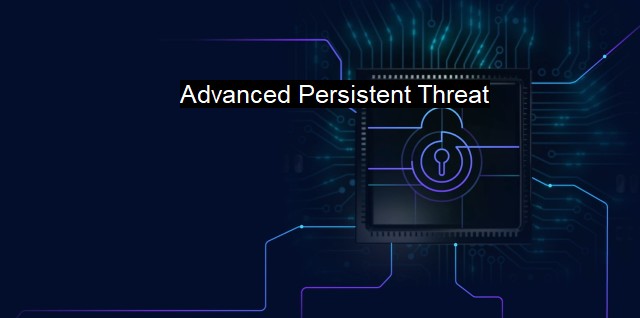What is Advanced Persistent Threat?
Understanding Advanced Persistent Threats: The Silent Cyber-Espionage Campaigns That Can Last for Years
An advanced persistent threat (APT) is a systematic cyber attack planned and executed by professional hackers and organized cybercrime entities, with the objective of gaining unauthorized access and remaining undetected for an extended period. These threats often target confidential information, aiming to either siphon the data away or inflict significant damage to an organization's infrastructure. One of the distinguishing factors of APTs is their persistence, sophisticated methodologies, and primary focus on specific targets, making them an exceptionally grave concern in the realm of cybersecurity.APTs typically exploit vulnerabilities in the network's internal or external security layers. The attackers utilize tailor-made malware, often designed to bypass conventional antivirus and anti-malware software. Unlike other types of threats, APTs are not driven by a random and opportunistic rationale; they aim to compromise key assets within a specified organization. Identified targets frequently include organizations in niches such as national security, defense industries, and high-value commercial industries.
Interestingly, it is the stealthy and lingering nature of APTs that make them especially fretful. After initial invasion, the attackers work cogently to avoid detection from defensive measures deployed by the system. Instead of exploiting the system immediately upon gaining access, they often lay dormant for weeks or even months, carefully mapping the environment, escalating permissions, and exfiltrating critical data – often without raising any red flags. A successful APT will have worked undetected in the system for an extended period until the attacker decides to strike or move on.
Typical antivirus software, designed around identifying and neutralizing generic types of malware, often find it challenging to detect these advanced attacks. This is due to the myriad of 'zero-day vulnerabilities', polymorphic or custom-created malware in the cyber-arsenal of well-resourced attackers. Hence, organizations must enhance their defense with cutting-edge cybersecurity tools that comprise network intrusion detection systems, encryption tools, firewalls, and endpoint threat protection in addition to traditional antivirus and antimalware software.
Educating employees on recognizing and reporting phishing attempts as well as cybersecurity hygiene helps mitigate the risks of APT breaches. Ensuring the use of strong encryption techniques and implementing robust access controls limit the damage in case of a breach, allowing analysts more time to flag and address the invasion before it causes large-scale damage.
Businesses can subscribe to proactive threat intelligence services for early detection-treatment cycle, decoding established patterns and analyzing newly discovered ones. Collaborating with other entities, both within the sector and those from auxiliary sectors, to share intelligence about APTs accelerates step-level improvements in cybersecurity procedures.
Mitigation of APTs also includes the capacity to swiftly react after a breach. This involves identifying compromised systems, isolating them, comprehending the depth of the compromise, and cultivating strategies to return to standard activities. Analysing the point of entry provides insights into identifying future vulnerabilities and helps in creating directives to minimize them.
While technology evolves, so do the threats, exposure, and potential consequences of breaches. Therefore, APTs will continue to impact modern organizations, demanding critical investment and ongoing attention toward developing superior cybersecurity measures. APTs will need active engagement from all stakeholders, including management boards, CEOs, CTOs, cybersecurity professionals, and employees across the organization.
Although complexities surrounding the mitigation of APTs are overwhelming, by fostering a culture of security building, embracing multilayered defense strategies, and enhancing the organizations' capability to react and recuperate post-breach, these threats can be significantly minimized. Understanding and acting against APTs is, thus, a necessity in a digitally interconnected ecosystem, offering opportunities for organizations to improve and innovate their business practices and relationships with customers further.

Advanced Persistent Threat FAQs
What is an "advanced persistent threat" (APT)?
An advanced persistent threat (APT) is a sophisticated cyber attack that is designed to gain unauthorized access to a computer network or system and remain undetected for an extended period of time.What are the characteristics of an APT attack?
APTs are characterized by their advanced tactics, techniques, and procedures (TTPs), which are designed to evade detection and maintain access to the target system over an extended period of time. They are typically carried out by highly skilled and well-resourced attackers, and often involve multiple stages and phases.What are some common targets of APT attacks?
APTs can target a wide range of organizations and industries, but they are typically aimed at high-value targets such as government agencies, financial institutions, and large corporations. These attacks can be highly targeted, with attackers using social engineering tactics and other methods to gain access to sensitive information and valuable intellectual property.What can organizations do to protect themselves from APT attacks?
To protect themselves from APT attacks, organizations should implement a multi-layered defense strategy that includes measures such as network segmentation, intrusion detection and prevention systems, file integrity monitoring, and regular security audits and assessments. They should also provide their employees with regular training on cyber security best practices, such as how to identify and avoid phishing scams and other social engineering tactics.| | A | | | B | | | C | | | D | | | E | | | F | | | G | | | H | | | I | | | J | | | K | | | L | | | M | |
| | N | | | O | | | P | | | Q | | | R | | | S | | | T | | | U | | | V | | | W | | | X | | | Y | | | Z | |
| | 1 | | | 2 | | | 3 | | | 4 | | | 7 | | | 8 | | |||||||